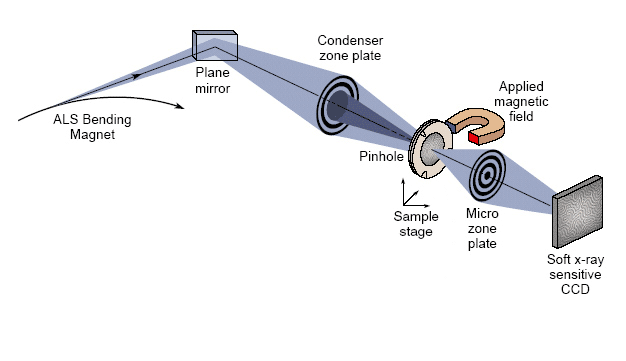The Center for X-Ray Optics is a multi-disciplined research group within Lawrence Berkeley National Laboratory's (LBNL) Materials Sciences Division (MSD). Notice to users.
X-ray imaging of nanoscale structures and processes.
XM-1, a soft x-ray full-field microscope.
"Many exciting areas of research require observing the dynamics of nanoscale systems. Researchers from around the world use XM-1's unique combination of 10-nm spatial resolution and 70-ps temporal resolution to study nanoscale properties that are challenging or impossible to see in other ways."
Mi Young Im,
Principal Investigator

XM-1: The world's highest resolution zoneplate microscope.
XM-1 combines: spatial resolution approaching 10 nm, elemental specificity, 70 ps temporal resolution (set by the bunch length of the x-ray pulses), and high sensitivity to spin configurations (via dichroism effects with polarized x-rays) making it a unique analytical tool for nanoscience research. Every day, scientists working in areas such as spintronics, nanoscale materials science, x-ray optics and environmental sciences come to XM-1 to unlock nanoscale properties that are challenging or impossible to see in other ways.
XM-1 schematic

XM-1 specifications
| Source | Bend magnet |
| Energy range | 500-1300 eV |
| Monochromator | Zone-plate linear |
| Flux | Images with 1000 x 1000 pixels, 1000 photons/pixel recorded in 3 s at 517 eV with 0.2% BW (ALS at 1.9 GeV, 400 mA) |
| Spectral resolution (E/ΔE) | 500-700 |
| Spatial resolution | Typical 25 nm (best value 10 nm) |
| Field of view | 15 µm single field; virtually unlimited larger areas can be tiled together like a mosaic |
| Detector | Back-thinned 2048- x 2048-pixel CCD camera |
| Equipment | Various fast electronic pulsers for spin dynamics, fast sampling oscilloscope, polarization selecting aperture |
XM-1 sample information
| Format | Thin films deposited typically on Si3N4 membrane (similar to TEM substrates) or other x-ray-transparent substrates |
| Preparation | Sample dependent |
| Environment | External magnetic fields up to 5 kOe in beam direction and 2 kOe along the sample plane; tilted sample holder for in-plane magnetized samples; He at atmospheric pressure, wet or dry |



